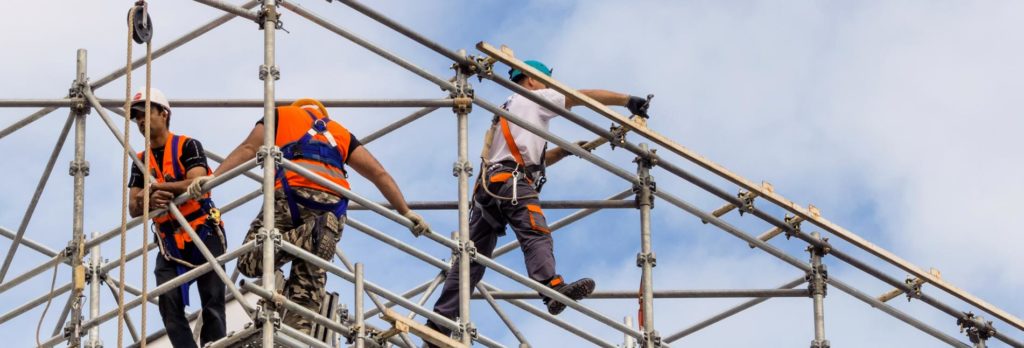Scaffolding is one of the most useful ways to work on the side of a building or high overhead without hanging off a ladder. When assembled correctly, scaffolding provides a safe and stable working area to keep the whole site safe and secure. But some things can affect the way your scaffold performs. Weather is one of those things, and you often can’t do a lot to change that. The past few weeks have been an incredibly windy, stormy time here in Cornwall so today we look at how to wind-proof scaffolding.
How Do You Wind-Proof Scaffolding?
With numerous powerful storms whipping up around our coastline and giving the whole Duchy a battering, our thoughts turn to wind-proofing scaffolding and advising our clients what they can do to protect their construction sites from the wind, rain and incessant stormy weather.Safety, as always, begins with preparation and taking adequate safety measures before the event. But there are important things to consider (and actions to be taken) both during and after periods of stormy weather to wind-proof scaffolding structures and construction sites. Before the wind starts (hopefully this has all been done before now!) it is of course imperative that all scaffolds are erected in accordance with guidance from manufacturers’ user guides, technical guidance and with the appropriate scaffold design. If you’ve used the professional scaffolding team here at 7 Bays Scaffolding, you can rest assured that this will all have been taken care of and your scaffolding will be erected safely and exceeding safety guidelines.
Risk Assessments
Responsible employers will have carried out a risk assessment which includes weather conditions in their report and look at how to wind-proof scaffolding. This report should identify an individual who is responsible for suspending works in the event of dangerous weather. Making sensible, safety-based decisions in advance of the storms is the very best way to mitigate risk and ensure that everyone remains safe.
Preparation is Key
We take the time to undertake regular safety inspections on our scaffolding structures to check that each adheres to our meticulously high safety standards. Of particular concern during periods of strong wind are bracing and tie arrangements. When ties are properly installed the chance of failure is massively reduced because scaffold designs take high wind speeds into account when calculating of tie loads at the planning stage. Even 70-80 mph winds as we’ve been experiencing here in Cornwall is usually taken into account as it is known that this sort of weather can and does occur. Especially in the wilds of blustery Cornwall!
“Batten Down the Hatches”
In stormy weather it’s crucial to ensure that all scaffold boards are adequately secured (e.g. with board retaining couplers or other relevant systems) and to ensure that any sheeting, netting or temporary roofing is adequately secured or even removed if necessary. It is also important that loose materials are not left exposed to the wind so it will be your responsibility to remove any equipment, tools or other movable items from the scaffolding area to mitigate the risk of winds carrying them into the air. The risk of falling items is a huge concern in high winds and a thorough risk assessment and wind-proofing measures should be carried out if stormy weather is forecast.
Don’t Handle Scaffolding Equipment in High Winds
Handling scaffolding components, especially items like long scaffold poles and large scaffold boards, pose a real risk when winds are high. Not only does it pose a risk to workers handling loose and large equipment, but it is also dangerous for passersby and anyone working below. Sheeting can act like a sail in high winds and so handling anything which puts you at risk whilst the weather is raging around you should be halted until calmer weather returns.
Be Sensible and Protect Your Workers
Once the winds have started, it will be crucial to assess whether your workers are able to work safely in the conditions or whether you will have to call the project off until the weather calms. It’s crucial to stand down if high winds are expected. Nothing is more important than the safety of your workforce and the people passing by below, so we strongly advise to edge on the side of caution in all circumstances. Never use a suspended scaffold in high winds or during storms. At minimum, do not work on the scaffold when winds are in excess of 25mph. Losing half a day’s work is better than losing the health or life of one of your colleagues.
The Calm After the Storm
Finally, when the winds have abated, scaffold inspections should be executed to assess any damage and any risks which may have been caused by such stormy weather. It’s important to pay particular attention to tie locations to ensure that nothing has failed or worked loose. Sheeting may well have to be reinstated (given that sheeting is often designed to come loose in such circumstances as a safety measure to ensure the integrity of the scaffold itself).
The Work at Height Regulations 2005 guidelines state when a scaffold isn’t assembled to a generally recognised standard configuration, then the scaffold should be designed by a competent person using bespoke calculation to ensure it will have adequate strength, rigidity and stability while it is erected, used and dismantled. This is extremely important and shouldn’t be overlooked. If you need help with wind-proofing your scaffolding then please get in touch with us here at 7 Bays Scaffolding and we will be only too happy to assist.




